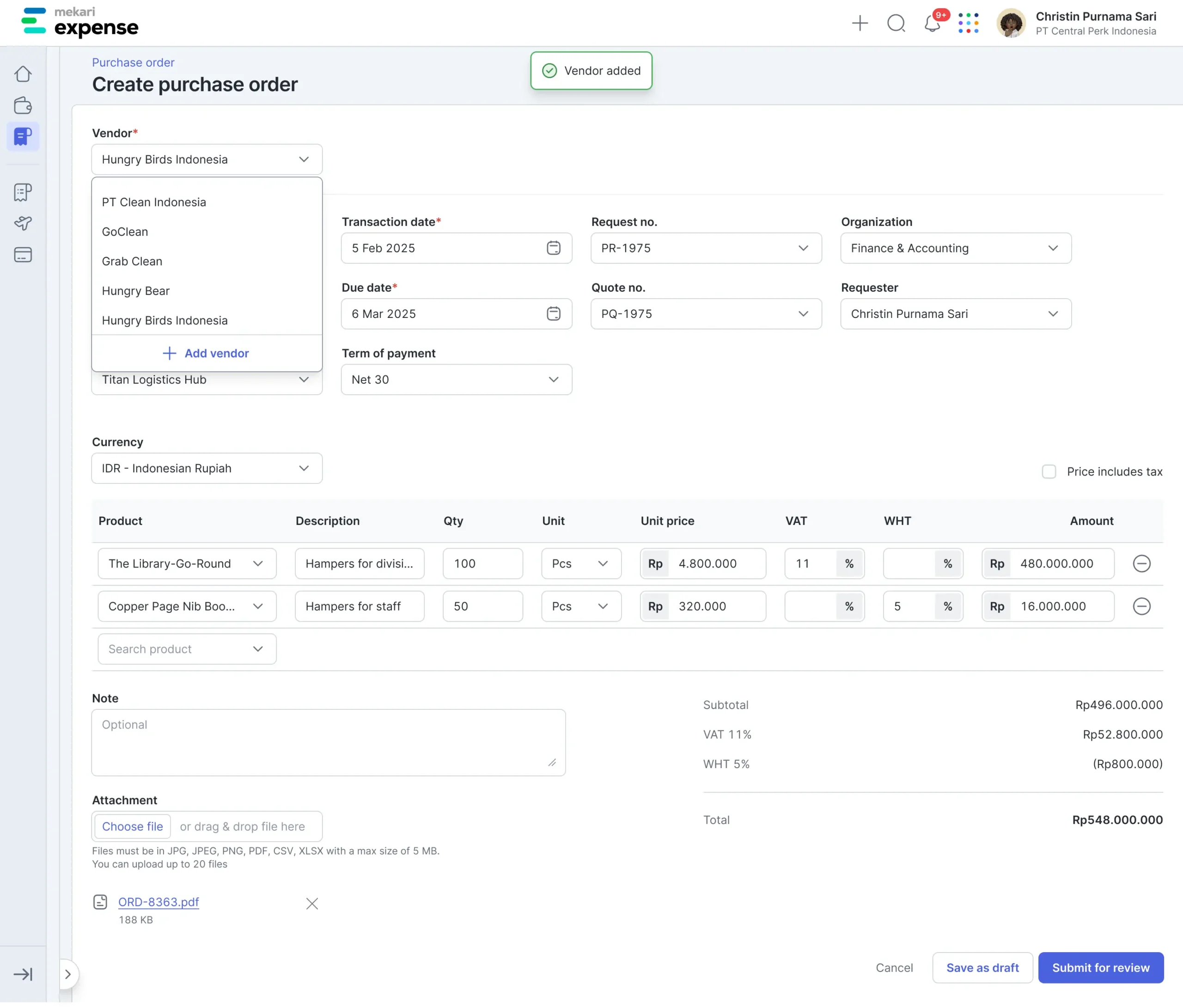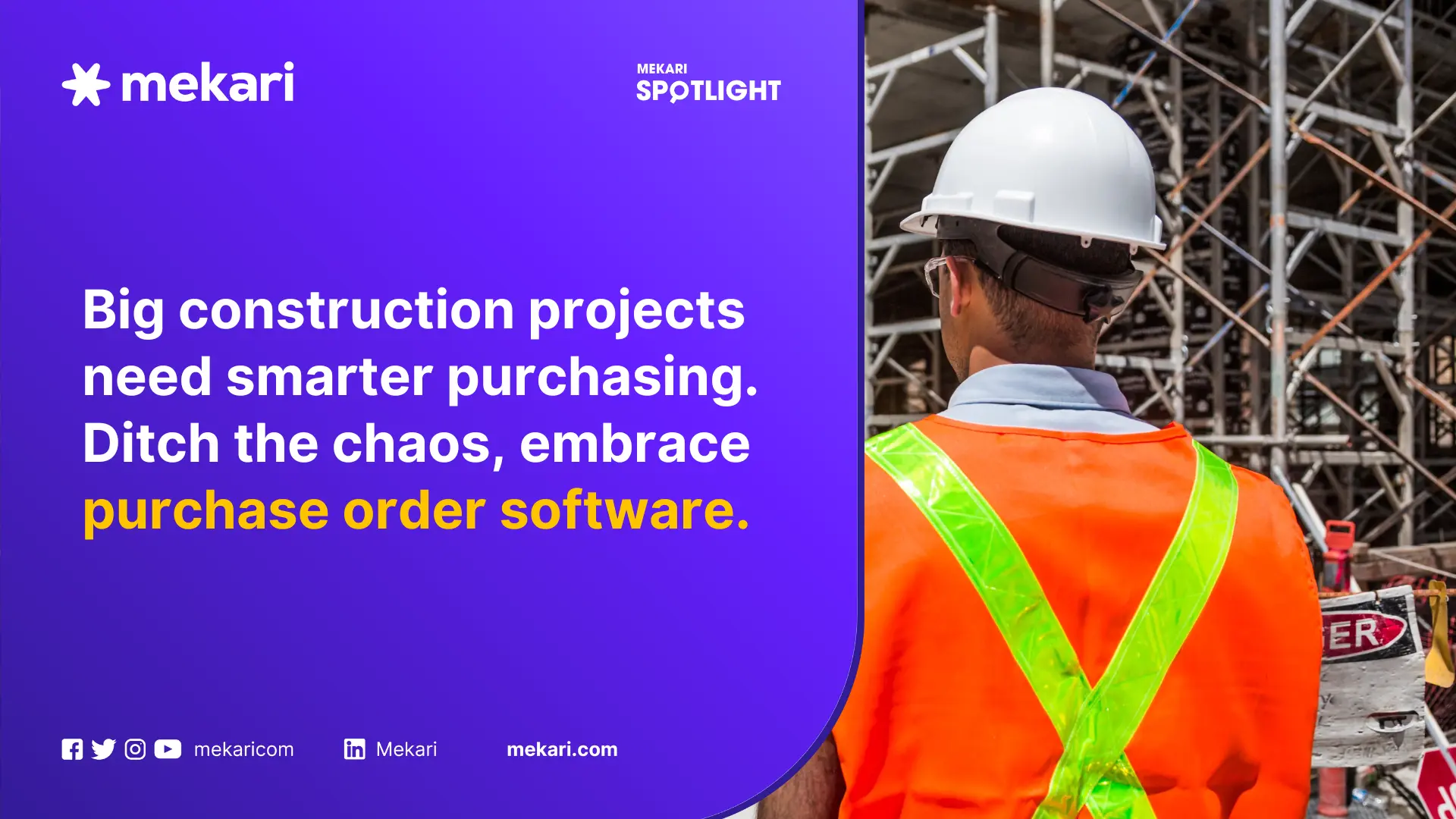Mekari Insight
- Managing purchases across multiple job sites and vendors with spreadsheets or paper leads to chaos, delays, and cost overruns.
- Features like automated approvals, real-time tracking, and system integration help teams work faster, avoid duplicate orders, and gain full visibility into project costs—cutting procurement times by up to 30%.
- Built for project-based work, Mekari Expense Purchase streamlines the entire procurement lifecycle—from issuing POs to payment—helping you stay in control, stay on budget, and scale with confidence.
Construction companies often deal with messy procurement processes—materials change all the time, site and office coordination is tricky, delivery schedules rarely match project timelines, and manual tools like Excel or paper forms just don’t cut it anymore.
To address these operational inefficiencies, the most effective solution is implementing a Purchase Order; (PO) software. This tool is specifically designed to streamline procurement workflows, improve coordination, enhance transparency, and ensure timely delivery of materials.
But with so many options out there, how do you choose the right one for your construction business? Let’s break it down.
Construction purchase order software

A purchase order is a formal document sent by a buyer—usually a general contractor or project owner—to a seller, like a supplier or subcontractor. It authorizes the purchase of specific goods or services and spells out the key details, such as:
- What’s being purchased (e.g., cement, steel bars, scaffolding)
- How much is needed (quantity)
- Agreed price per unit or total cost
- Delivery date and location
- Project code or reference number
- Payment terms and conditions
Now, here’s where construction purchase order software comes in.
Instead of managing POs through messy email chains or spreadsheets, this software lets you create, approve, send, and track purchase orders—all in one place, digitally.
It’s built specifically for construction teams, so you can:
- Align site needs with procurement plans
- Route POs for approval automatically
- Track delivery status in real time
- Assign POs to specific projects or cost codes
- Keep a clear audit trail for every transaction
In short, it takes the chaos out of construction procurement and helps you stay organized, on budget, and on schedule.
Why construction companies need purchase order software
Perhaps most importantly, purchase order software helps mitigate key risks that plague manual procurement. Consider a few of the big challenges that PO software can help you tackle:
1. Complexity of managing multi-site and multi-vendor procurement
Handling procurement across multiple job sites and vendors using manual tools is messy and inefficient. Large construction projects typically take 20% longer and run up to 80% over budget, often due to poor coordination and outdated procurement methods.
PO software centralizes purchasing, reduces duplicate orders, and streamlines communication across teams.
2. Need for centralized, transparent, and real-time processes
Without real-time visibility, it’s hard to track what’s been ordered, what’s approved, and what’s delayed.
A PO system gives everyone—from site teams to head office—one source of truth, speeding up procurement cycle times by up to 60% and improving collaboration across locations.
3. Risk management
Manual processes increase the risk of delays, cost overruns, and compliance issues. PO software helps prevent these by:
- Automating approval workflows
- Flagging duplicate or over-budget orders
- Logging every transaction for easy audits
With better controls and transparency, companies avoid costly mistakes and gain more confidence in every purchase.
Key benefits and impact on construction workflows
To truly understand the value of purchase order software in construction, it helps to look at the specific features that drive efficiency, accountability, and cost control. Here’s how each one contributes to a more streamlined workflow:
1. Centralized documentation
All purchase orders, approvals, and receipts are stored in one place, making them easy to track and audit. Workers spend up to 15% of their time searching for documents, and companies may lose around $220 to reproduce a lost one.
A centralized digital system eliminates this waste, reduces the chance of lost paperwork, and significantly improves audit readiness.
2. Budget control & real-time project cost tracking
Linking purchase orders to live budgets ensures teams stay within limits and spot potential overspending early. Real-time visibility into committed costs improves forecasting and reduces financial risk.
Companies using integrated PO systems are 2.5 times more likely to complete projects on budget, with some firms reporting up to 20% savings in procurement-related costs.
3. Faster approvals workflow
Automated workflows ensure that each PO reaches the right person without delay. This speeds up decision-making and prevents bottlenecks, even when key approvers are off-site.
Digital workflows result in approvals being completed 3.5 times faster, and companies report up to 30% shorter procurement cycle times overall.
4. Reduced errors
Standardized templates and digital entries significantly reduce the chance of human error. Manual entry error rates can e timesceed 1% per field, leading to costly mistakes.
PO software eliminates duplicate orders and mismatched records, resulting in fewer disputes and smoother vendor interactions.
5. Faster procurement process
PO software streamlines the entire purchasing workflow—from request to delivery—helping teams move quickly and efficiently.
Digitized systems can cut total procurement time by up to one-third, meaning materials arrive faster and projects experience fewer delays due to supply issues.
6. Enhanced communication & coordination between stakeholders
With a single platform, suppliers, site managers, and finance teams stay aligned. Real-time updates reduce confusion and eliminate redundant follow-ups.
Teams using integrated, real-time tools report 25% fewer project delays, thanks to better visibility and coordination.
7. Integration with inventory and accounting systems
PO tools that sync with inventory and accounting systems eliminate manual double-entry and reduce discrepancies.
Integration improves operational efficiency by 35%, cuts inventory carrying costs by 10–15%, and provides accurate, real-time data to avoid overordering or stockouts.
8. Better compliance and audit trail
Every step of the PO process is logged, creating a secure and traceable digital trail. This structure reduces audit-related costs by up to 40%, enforces internal spending rules, and simplifies tax preparation and regulatory reporting by keeping all records organized and accessible.
Types of construction purchase orders
Selecting the right PO type based on the scope, frequency, and urgency of the procurement need can lead to better control, faster fulfillment, and stronger supplier alignment.
1. Standard purchase orders
Standard POs are used for one-time purchases of specific goods or services. These documents include clear details on quantity, price, delivery schedule, and payment terms. They’re commonly used when a purchase is not covered by an ongoing agreement.
For instance, if a site manager needs a specific type of scaffolding not stocked on site, they would issue a standard PO to the supplier. This ensures full documentation and alignment on what’s being purchased and when it should be delivered.
2. Planned purchase orders
Planned POs are issued when future procurement needs can be anticipated. These orders define general expectations for quantity, delivery timelines, and pricing but don’t finalize dates. They’re ideal for long-term projects where usage is predictable but deliveries vary.
For example, a multi-phase infrastructure project may require cement deliveries every month for a year. A planned PO outlines the intent to purchase a set volume over time, while each actual order is released as a “release” against the plan.
3. Blanket purchase orders
Blanket POs cover recurring purchases with a specific vendor over a defined period, typically six months to a year. They simplify procurement for frequently used items and allow construction teams to draw down on an agreement without creating a new PO each time.
Say a contractor regularly rents portable lighting from the same equipment vendor. Instead of raising individual orders for each rental, they issue a blanket PO that caps spending and predefines terms.
Key features to look for in construction purchase order software
When selecting construction purchase order software, it’s important to consider the following key features to ensure efficiency and streamline the procurement process.
1. Standardized PO templates
Using consistent, digital templates minimizes manual entry and prevents errors. Companies using e-procurement tools report significantly fewer data entry mistakes, helping reduce costly rework and miscommunication.
- Minimizes data entry mistakes by auto-filling vendor, item, and pricing info
- Keeps all orders clear and easy to track across teams
- Reduces costly rework and miscommunication on-site
Manual data entry error rates can e timesceed 1% per field, which adds up fast on high-value orders.
2. Automated approval workflows
Chasing down signatures delays procurement. Automated workflows send POs through the right approval channels, instantly.
- Speeds up internal approvals without back-and-forth emails
- Enforces spend policies by setting thresholds and multi-level approvals
- Keeps orders moving even when managers are off-site
Companies using e-approvals process invoices 3.5 times faster and cut procurement cycle times by 30%.
3. Budget control & real time project cost tracking
Construction projects live and die by the budget. Real-time cost tracking ensures you’re always in control.
- Links every PO to project budgets for real-time visibility
- Flags potential overruns before they happen
- Helps forecast upcoming spending with more accuracy
Firms with integrated PO tracking are 2.5 times more likely to stay on budget and have reported up to 20% in cost savings.
4. Mobile access
Your teams aren’t tied to a desk—your PO system shouldn’t be either.
- Field teams can submit or approve POs from their phones
- Prevents procurement delays due to staff being off-site
- Keeps site and office connected in real time
Mobile access helps accelerate material approvals and keeps projects moving without interruption.
5. Integration capabilities
A good PO system doesn’t work in isolation—it connects with your other tools.
- Syncs with accounting software to automate invoice matching
- Links with inventory systems to avoid over-ordering or stockouts
- Connects with project management platforms to align timelines and budgets
Integrated systems improve operational efficiency by 35% and reduce inventory costs by 10–15%.
6. Audit trail
Need to review or justify purchases? A digital audit trail has your back.
- Automatically records every action taken on a PO
- Simplifies compliance with internal policies and e timesternal audits
- Builds trust and accountability across the organization
Companies with built-in audit trails reduce audit-related costs by up to 40%.
7. Vendor management
Managing supplier relationships is easier when all your info is in one place.
- Tracks vendor performance and pricing history
- Streamlines reordering from preferred suppliers
- Helps resolve disputes faster with centralized records
Digitally connected vendors are 30% more satisfied, often resulting in faster service and better pricing.
8. Reporting & analytics
Procurement data is powerful—if you know how to use it.
- Offers insights into spending patterns and supplier performance
- Identifies cost-saving opportunities and inefficiencies
- Helps management make informed, data-driven decisions
Companies using procurement analytics are twice as likely to stay on schedule and reduce costs.
Recommended construction purchase order software
If you’re looking for a construction PO solution that grows with your business and adapts to complex, project-based needs, Mekari Expense Purchase is a top choice.
Designed for flexibility and scalability, it’s an ideal fit for construction companies managing multiple sites, vendors, and dynamic procurement schedules.
With Mekari Expense Purchase, your entire procurement process becomes more efficient—from issuing purchase orders to tracking approvals and completing payments. The platform helps teams easily manage material orders, monitor budgets in real time, and ensure every transaction is logged for accountability.
Most importantly, it simplifies the payment process by integrating seamlessly with finance workflows, so you can avoid delays, reduce errors, and maintain full visibility from PO to payment.
Whether you’re standardizing procurement across teams or scaling operations across regions, Mekari Expense Purchase gives you the control and visibility you need.
References
ProcureDeck. ‘’Top 5 Purchase Order Software for the Construction Industry’’
Tradogram. ‘’Construction Purchase Orders: Full Guide’’

